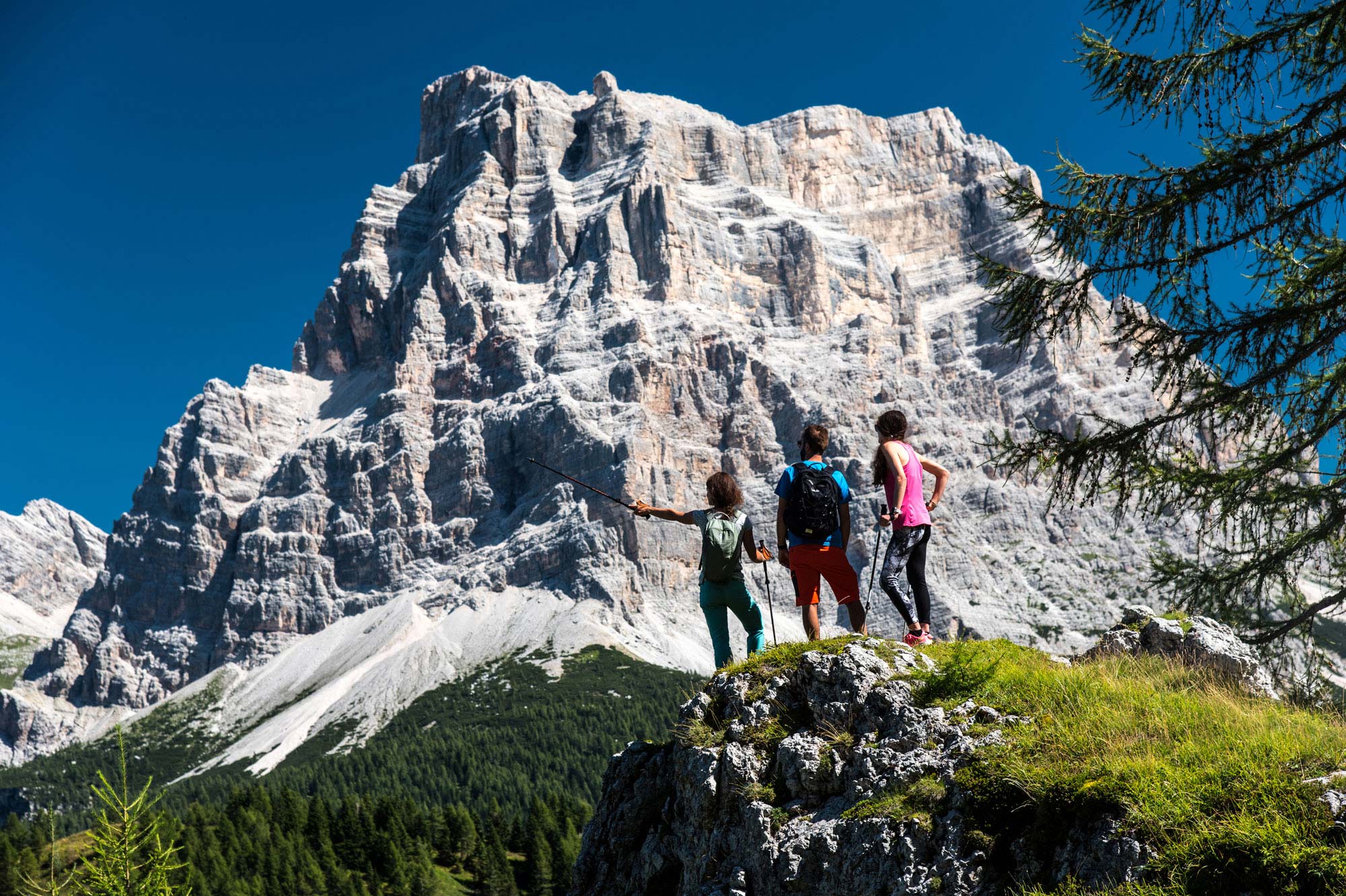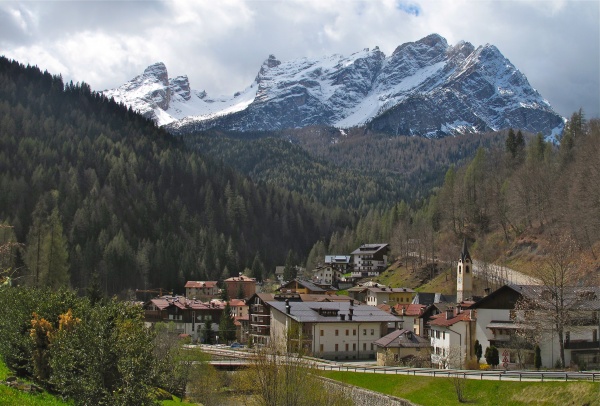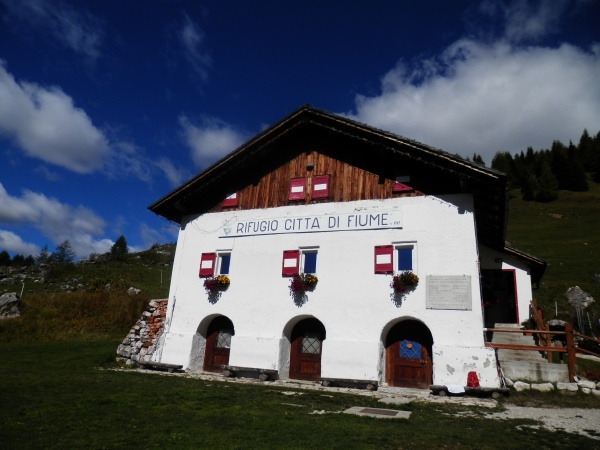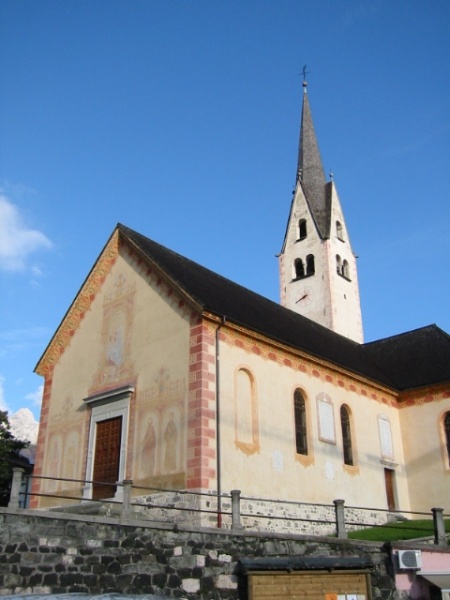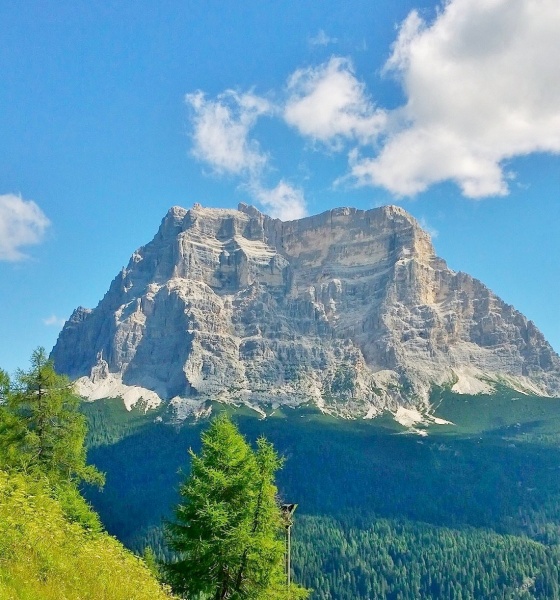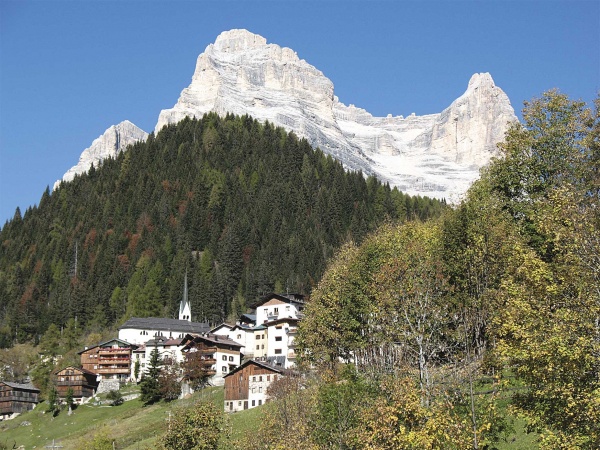The Val di Zoldo is in a central position in the Dolomites, and offers a host of attractions, some of which are listed below:
Longarone
[dis. Forno almost 19 km – dis. Pecol almost 29 km]
The Vajont tragedy
Longarone is an agreeable little town a few kilometres from the Val di Zoldo. It is mainly remembered for a tragic event in his history, which marked an important, sobering warning from nature against Man’s reckless thirst for progress and financial gain. On 9 October 1963, at 10.3 p.m., a massive wave triggered by a landslide from Monte Toc, in the artificial Vajont basin, swept away the whole of Longarone and the surrounding villages, killing almost 2000 people. Many families were torn apart, houses swept away, and the whole community had to start over again from scratch, but Longarone has never forgotten, and continues to bear witness to a terrible tragedy that many saw coming. Today the Vajont disaster is illustrated and explained in a number of symbolic places in the area, including the museum “Attimi di storia” (Moments of history) in Gonzaga's square; the monumental church by Michelucci in the centre of the town; the cemetery of the Vajont victims in Fortogna; the dam itself, accessible with a guided visit; the bell tower of Pirago, one of the few constructions left intact after the wave swept through the area. Highly recommended come the guided visits, to find out more about a story of great suffering, but also of hope, of a desire to start over and to ensure such a tragedy never happens again.
Castellavazzo
Part of the municipality of Longarone from 2013, Castellavazzo owes its renown to the craftsmanship skill of its stonecutters and to the fine-quality stone quarried here. In a strategic position along the Piave Valley, it was ideal for defending the area and controlling trade between the Cadore and the other areas in the north with the plain. This effective defensive function is testified to by the Gardona tower, built in 1171, with a triangular ground plan, of which only the remains can now be seen, reachable with a short and easy walk. Interesting places to find out more about the history of Castellavazzo include the Stone and Stonecutters’ Museum, recently restored and in the centre of the village, as well as the village centre and the fountain.
Longarone Fiere
The only trade fair centre in the province of Belluno, Longarone Fiere hosts a variety of events, including some of the best-known in the region, such as Agrimont, the spring fair focusing on agriculture; Arredamont, the furniture and mountain building fair, and MIG, the fair focusing on the artisan ice cream that has made an important contribution to the fortunes of areas such as the Zoldano and Cadore areas, as well as the Longarone area itself. MIG takes place at the beginning of December every year, and welcomes not only professionals from the ice cream business, but also consumers, who are entertained with plenty of events, surprises…and the chance to taste some of the ice cream.
Selva di Cadore
[dis. Forno almost 23 km – dis. Pecol almost 14 km]
Andria
Delightful little village in the Municipality of Selva di Cadore, in the Val Fiorentina, at the foot of Monte Cernera (Unesco system 1, Pelmo - Croda da Lago). This is one of the most ancient settlements in the Val Fiorentina, and is a classic Dolomite village, with its characteristic wooden homes and tabiei (haysheds), with barconele, the two-light windows typical of the Selva area. As you stroll through Andria, you can still breath in the typical country area of the age-old village, with its carefully tended meadows, sunny position and the Toffol mill, recently restored and open to visitors in the summer. Other attractions in the village include the beautiful little church of the Madonna della Neve, built in wood throughout, as well as the little church of Sant’Osvaldo, the faer for drying beans and the travai, for branding cattle. The village is surrounded by some of the most beautiful mountains in the Dolomites, such as the Pelmo, Civetta and Marmolada. Visitors are advised to pick up the booklet with the culture route in Andria from the tourist office in Selva di Cadore.
Mondeval and the Vittorino Cazzetta Museum
Selva di Cadore was the birthplace of one of the greatest explorers of the Dolomites, Vittorino Cazzetta, who between the 1970s and 1980s made some hugely important finds among his mountains, which have made a uniquely important contribution to geology, history and science. The most famous of these discoveries was perhaps Mondeval Man, a nomadic hunter from the Mesolithic who lived 7500 years ago in the wide-open spaces of Mondeval, a splendid plateau in system 1 of the UNESCO Dolomites (Pelmo - Croda da Lago). The burial place of Mondeval Man, at the highest altitude in Europe from the Mesolithic, has provided us with important information regarding the habits, diet and environment of the time, recorded and published by academics of the University of Ferrara. The discovery of the Mondeval burial site was followed by further study, with archaeological digs such as the one at Malga Staulanza, and findings such as those from the archaeological site of Mandriz, also in Selva di Cadore. Vittorino also played a key role in another important find, this time in the Zoldano area: the dinosaur tracks on a rock at the foot of the Pelmetto, the first indication testifying to the existence of dinosaurs in Italy millions of years ago. These are stories Vittorino wanted to keep alive for further generations, and the finds can be seen today in the Vittorino Cazzetta Museum in Selva di Cadore, open virtually all year, which hosts a number of fun events and activities.
Agordo and the Val Imperina
[dis. Forno almost 24 km – dis. Pecol almost 28 km]
Agordo, a little town linked to the Val di Zoldo by the Duran Pass, is the main town in the Agordino area. Once an important mining centre, thanks to the nearby Val Imperina mines, Agordo has written one of the oldest and most important chapters in Italian mining history. The Val Imperina mines operated for over five centuries (the earliest mentions of the activity date back to the early 15th century), producing copper at first, followed by pyrite, before closing in 1962. Today the mining village is open to visitors, who can admire the old smelting furnaces, the shaft and the opening of the Santa Barbara gallery. In addition to its mining history, Agordo is also well known, like the Cadore area, as one of the centres of production of quality eyewear in the province of Belluno.
Cibiana di Cadore
[dis. Forno almost 17 km – dis. Pecol almost 26 km]
An open-air museum. Cibiana di Cadore is known as the village of murals. In this little village in the Dolomites, in the shadow of the Sassolungo di Cibiana mountains, visitors can breathe in an atmosphere of days gone by, as they stroll through the narrow little streets amid the centuries-old dwellings. This is a place not to be missed especially during the “Festa dei murales”. In 1980, these fifty works, inspired by an idea that came from Osvaldo Da Col, chairman of the Pro Loco tourist association, and Vico Calabrò, a local painter from the Agordino area, transformed the municipality of Cibiana. The frescoes were painted on the walls of local buildings by artists of international renown, and they depict the history of the community that lived – and continues to live – in this little village of the Cadore. From centuries ago, represented by the mural painting with the “old woman and the soldier” to the more recent, trying times when the local folk had to emigrate, as well as cheerful popular festivals and events and the trades of the various figures who lived – or still live – in the local villages: it’s all here, depicted in these extraordinary works of art.
Colle Santa Lucia and “strada della vena”
[dis. Forno almost 27 km – dis. Pecol almost 18 km]
Built on a grassy hill between the Marmolada, Civetta and Pelmo, Villagrande in the municipality of Colle Santa Lucia is a dream for photographers from all over the world, since it is a perfect reflection of the classic mountain village as most of us imagine it. In addition to the splendid views, this little municipality in the province of Belluno has a history that stretches back a very long way. Once part of the Tyrolean lands of Ladinia, Colle was a mining village famous for Fursil iron, at the time renowned worldwide for its excellent quality. You can visit the Casa de Jan cultural centre in Villagrande, and walk along the “strada della vena”, the road once used to transport mining material between Colle and Andraz Castle, built in the area once under the control of Bressanone/Brixen, in the South Tyrol. Also highly recommended are the guided visits to the old mines, which take place in the Summer.
Alleghe Lake
[dis. Forno almost 33 km – dis. Pecol almost 24 km]
Alleghe Lake formed in 1771, following a landslide that created a natural dam over the Cordevole torrent. Today the lake is one of the most beautiful elements in the landscape of Alleghe, which visitors can admire as they walk or cycle along the path that runs right round it.
Sottoguda and its gorges
[dis. Forno almost 37 km – dis. Pecol almost 28 km]
From 2016 in the list of Italy’s most beautiful villages, Sottoguda, in the municipality of Rocca Pietore, is a charming little mountain village that springs to life in the Summer during “Na sera da zancan”, when little stands, exhibitions and entertainment enliven the splendid atmosphere amid the centuries-old homes. Sottoguda is famous above all, however, for the Serrai, 2,5 kilometres (from Sottoguda to Malga Ciapela) of narrow gorges carved out by the action of the water, with a wealth of waterfalls and grottos, under the magnificent Mamolada. In the Summer, the Serrai can be visited aboard a lovely little train.
Giau Pass
[dis. Forno almost 34 km – dis. Pecol almost 25 km]
This splendid Dolomite pass is a must in the summer for those who love the thrilling landscapes and colours of the mountains. Some 20 km long, the Giau Pass links the Val Fiorentina with Cortina d’Ampezzo, climbing up onto large mountain plateaus dotted with characteristic wooden chalets. Home to marmots and eagles, these huge open spaces are bordered by some of the best-known and best-loved peaks in the Dolomites, from the Nuvolau group to the Tofana di Rozes and the Lastoni di Formin.
Cortina
[dis. Forno almost 46 km – dis. Pecol almost 43 km]
The queen of the Dolomites, the town of Cortina is one of the best known in the Dolomites, and hugely popular with visitors. Famous for its chic allure, its boutiques and its unmistakable alpine style, it lies in a large basin surrounded by some of the most beautiful mountains in the Dolomites, guaranteeing a truly breath-taking view from above. Well worth a visit is the Regole Museum, with its magnificent fossil exhibits that tell the story of our mountains and the surrounding area, which offers a number of interesting attractions for nature lovers, such as the Dolomiti d’Ampezzo Natural Park.
Belluno and the Val Belluna
[dis. Forno almost 35 km – dis. Pecol almost 45 km]
Belluno is the capital of the province of the same name. The jewel in its crown is the splendid new Palazzo Fulcis museum in the town centre. The museum offers visitors the chance to find out about the history not only of Belluno, but of other areas in the province, with works by artists the whole province can be justly proud of, such as Andrea Brustolon, Simone da Cusighe, Valentino Panciera Besarel, Ippolito Caffi and Sebastiano Ricci. The Val Belluna area also offers plenty of cultural and natural attractions. Well worth a visit are: the Ethnographical Museum in Seravella di Cesiomaggiore, the Brent de l’Art canyon in Sant’Antonio di Tortal, the blue grotto in Mel, the Cadini del Brenton rock pools and the Soffia Waterfall in Sospirolo. A thrilling chapter in the area’s history regards the master swordsmiths of the valley of the Ardo Torrent, who forged some of the finest swords in Europe and indeed the world, such as those made by the Ferrara brothers. Today one of the most popular attractions of the Ardo Torrent area is the Bus del Buson, a natural gorge that in the summer is the setting for the “Armonie” music festival.
Santa Croce Lake and the Cansiglio Forest
[dis. Forno almost 38 km – dis. Pecol almost 47 km]
The largest in the province of Belluno, Santa Croce Lake is naturally windy, making it a paradise for kitesurfing, windsurfing and sailing fans. Also popular with visitors simply looking to enjoy a day in the sun, it has a large beach for relaxing by the shore. Further north, in the Alpago area, is the Cansiglio Forest, one of the most impressive nature areas in the whole of the Veneto region, with seven thousand hectares of beech, silver fir and Norway spruce trees and home to a variety of wildlife such as capercaillie and deer, whose unmistakeable call you can hear in the Autumn.
Erto e Casso and the Dolomiti Friulane National Park
[dis. Forno almost 30 km – dis. Pecol almost 39 km]
Erto e Casso is an ancient settlement in the Vajont valley. From the remains found here, we know Erto’s existence dates back to at least the Roman Age, although the historical event that had the biggest impact in the area’s history was the Vajont disaster, which changed the life of the entire community forever. In addition to the splendid architecture, these villages tell of a tragedy that must never be forgotten. The wild, difficult to reach mountains of Erto, bordering on those of the World Heritage Friuli Dolomites, are very popular with climbing aficionados, who enjoy the challenge of its cliffs, numerous routes of varying difficulty and the ferrata della memoria, a challenging route that climbs up to the Vajont sites. Erto e Casso is one of the municipalities that lie within the Dolomiti Friulane National Park, popular with the most romantic of mountaineers, who come here to climb the Campanile di Val Montanaia, and trekkers in search of adventure, who choose the Ciolesan Torrent to try the thrilling sport of canyoning.









